1. Introduction
ConfigSeeder® provides the capability to manage configuration data centrally. However, in the kubernetes world, the gitops methodology is beginning to gain momentum.
The Git-Connector is a ConfigSeeder that combines these two worlds:
-
Manage your configuration data centralized in ConfigSeeder
-
Let the Git-Connector distribute your configuration data to the git repositories
-
Your devops tools requiring a git repository as single point of truth will work with configuration data managed by ConfigSeeder
The following types of files can be provided to a git repository:
-
Files
-
with static content
-
with templated content
-
-
ConfiMaps
-
containing key/value pairs
-
containing templates
-
-
Secrets of type
Opaque-
containing key/value pairs
-
containing a key- or truststore
-
-
ImagePullSecrets (Secrets of type
kubernetes.io/dockerconfigjson)
1.1. Use cases
-
Periodic synchronization
-
Install the Git-Connector as a cronjob
-
Every some minutes it will synchronize the configuration data stored in ConfigSeeder to the configured git repositories
-
Depending on the configuration (of your connected gitops tools), your tools will either directly execute some actions or wait until you create a tag, merge a branch, …
-
-
Manual synchronization
-
Run the Git-Connector manually / integrated in a pipeline at specific events (e.g. before an application installation)
-
It will synchronize the configuration data stored in ConfigSeeder to the configured git repositories
-
Let your gitops tools execute their actions
-
2. Quickstart
2.1. Introduction
2.1.1. Content of the quickstart manual
The Git Connector is able to connect ConfigSeeder® to one or many Git repositories and push configuration data to Git. This quickstart guide gives an introduction to the use of the Git Connector.
You will understand, how
-
the Git-Connector can be configured
-
data to be pushed to Git can be defined in ConfigSeeder
This quickstart guide also offers links to more detailed information.
2.1.2. Preconditions
-
ConfigSeeder up and running
-
Git Server up and running (We recommend https://gogs.io/ for testing)
-
Connectivity to the Git Server and ConfigSeeder
-
Licence which supports the use of the Git Connector
2.2. Prepare ConfigSeeder®
2.2.1. Setup configuration groups and api key
-
Create a Configuration Group
git-connector-quickstart(the name of the Configuration Group can be chosen as desired)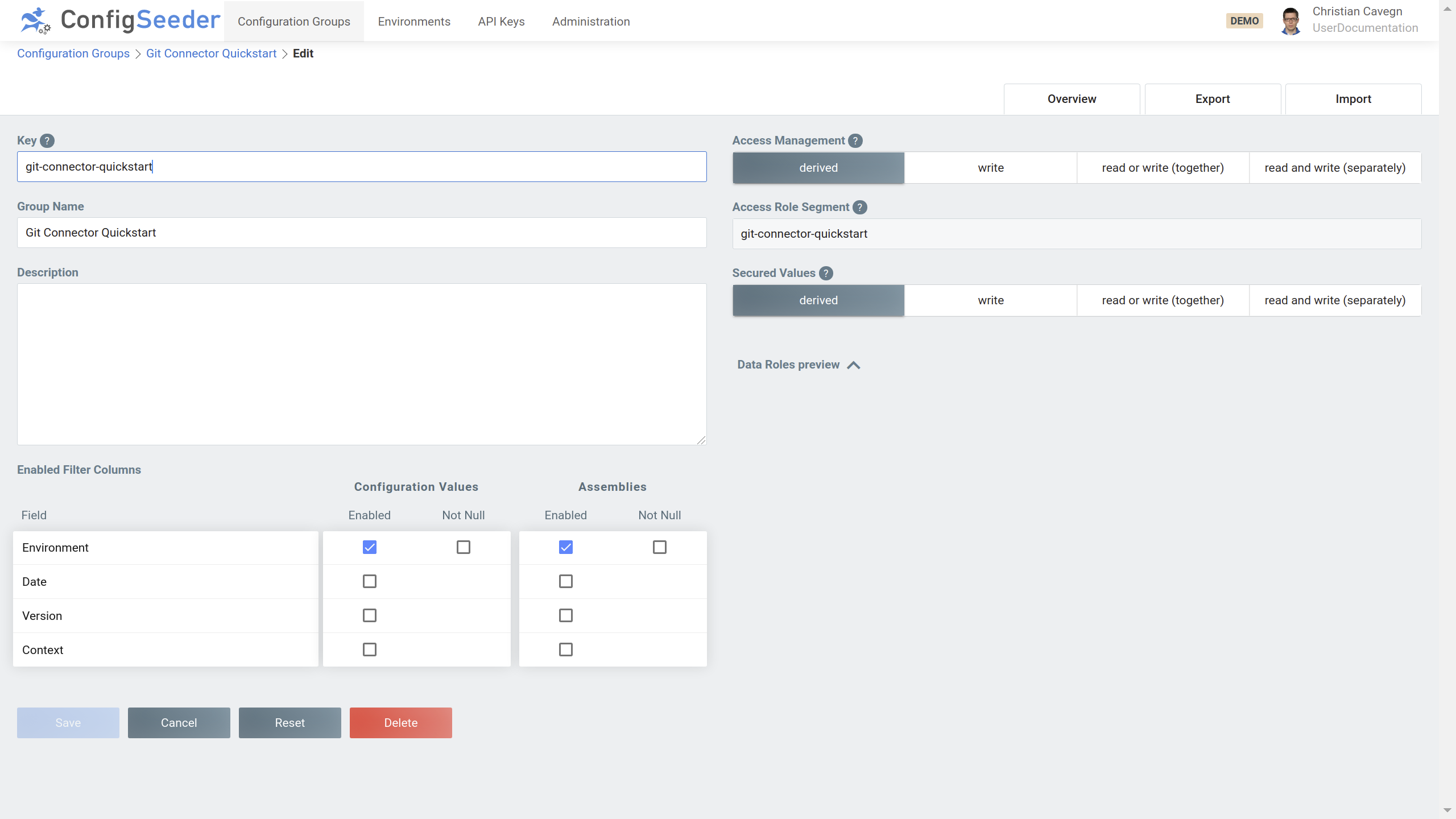
When creating the Configuration Group, just enable the filter column Environment and leave the security options on their default values.
-
Create the two environments
TESTandPROD(the name of the Environments can be chosen as desired) -
Create an api key with permission to access the Configuration Group
git-connector-quickstartand both environments.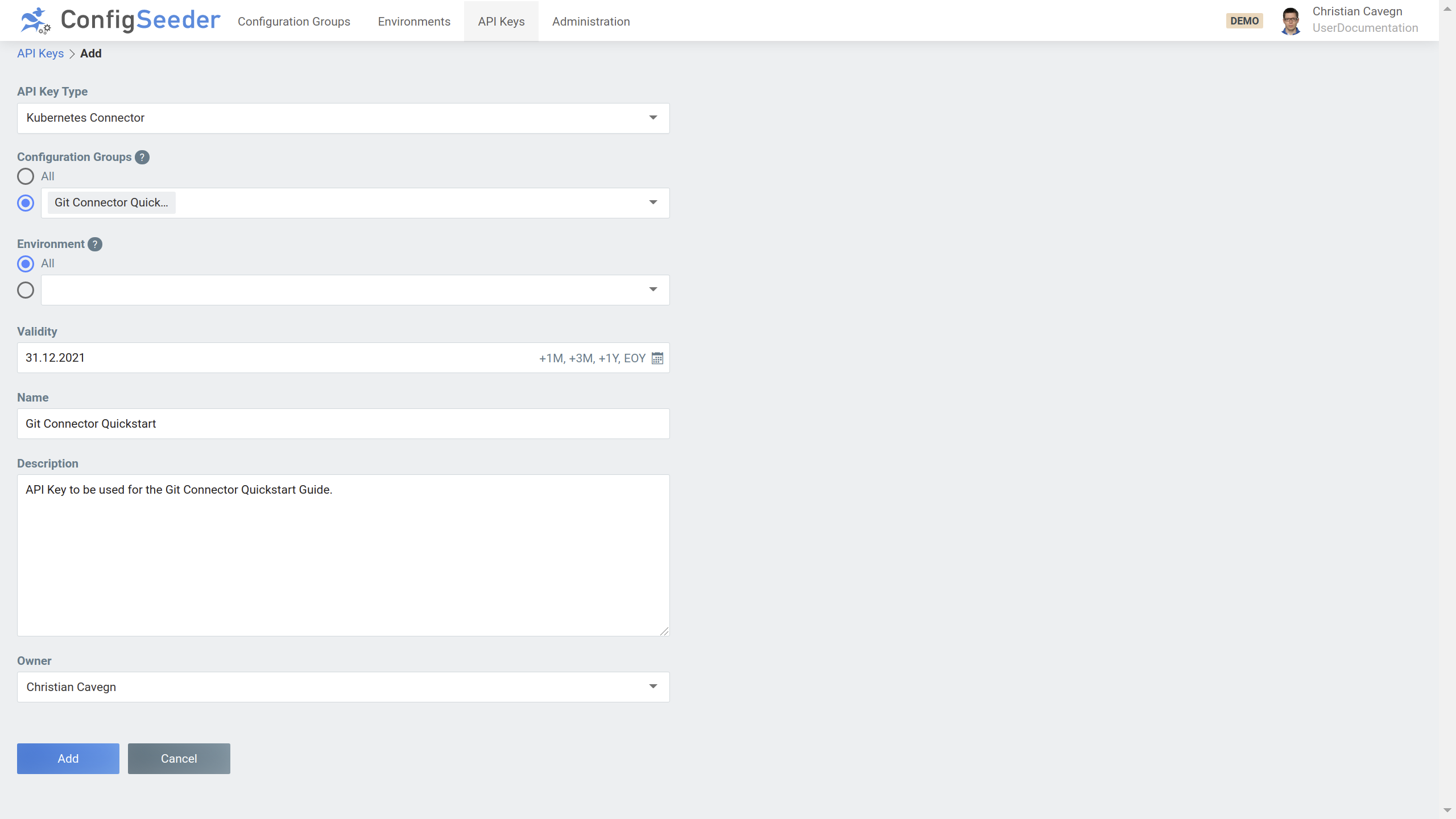
Copy the generated api key and store it in the file
git-connector-apikey.
|
At the moment, there is not api key of type Git Connector. Just select type Kubernetes Connector. |
2.2.2. Setup configuration data
-
Open the Configuration Group
git-connector-quickstart, switch to the Value Assemblies-Tab -
Create an assembly of type `ConfigMap: Key/Value (Git):

-
Create an assembly of type `Secret: Key/Value (Git):

2.3. Prepare Git Repository
2.3.1. Create Git Repository
-
Create the git repository git-connector-quickstart
-
Create an user git-connector with access permission to the previously created repository
|
The following assumptions are made in this Quickstart Guide:
|
2.3.2. Create synchronization configuration
Every Git Repository that will be a target of the Git Connector must hold at least one configseeder-gitsync.yaml.
In this example, the two environments TEST and PROD will be synchronized, therefore, two of these configuration files have to be created.
-
Create the file
configseeder-gitsync-test.yamlin the root of the Git Repository with the following contentconfiguration-group-keys: [git-connector-quickstart] environment-key: TEST -
Create the file
configseeder-gitsync-prod.yamlin the root of the Git Repository with the following contentconfiguration-group-keys: [git-connector-quickstart] environment-key: PROD
2.4. Execute Git Connector
2.4.1. Simple configuration
In this example, the git connector is configured in a very simple way. Goal is to create a json formatted file per Assembly in the Git Repository.
-
Download the helm chart of the Git Connector from https://configseeder.com/download/
-
Create a
git-connector-value.yamlfile with the following content:gitConnector: configseeder: url: "https://staging-postgresql-config-seeder.oneo.cloud" configmap: create: true content: |- connector: synchronizations: - application: Git Connector Quickstart environments: [test,prod] git-repository: http://gogs.git-server:3000/gitadmin/git-connector-quickstart branch-detection-pattern: ^master$ configuration-location: configseeder-gitsync-<environment>.yaml output-prefix: /configseeder/ secret: create: true basicAuthRequired: true basicAuthUsername: "git-connector" basicAuthPassword: "git-connector" psp: create: true -
Install the Git Connector
kubectl create ns git-connector-quickstart --dry-run=client -o yaml | kubectl apply -f - kubectl -n git-connector-quickstart create secret generic "git-connector-apikey" --from-file=apiKey=git-connector-apikey --dry-run=client -o yaml | kubectl -n git-connector-quickstart apply -f - helm -n git-connector-quickstart upgrade -i "git-connector" configseeder-git-connector-0.9.4+000.tar.gz --values git-connector-helm-value.yaml
When the Git-Connector has run for the first time, the following files will have been created in the Git Repository:
-
configseeder/configmap-prod.json
-
configseeder/configmap-test.json
-
configseeder/secret-prod.json
-
configseeder/secret-test.json
For example file TODO will have the following content:
{
"kind": "Secret",
"apiVersion": "v1",
"metadata": {
"name": "secret",
"namespace": "application-prod",
"creationTimestamp": null,
"annotations": {
"configseeder.com/dataHash": "72fcef6049eece721c76c329f01e674c32f026de56246074e0b0baac68353241",
"configseeder.com/managed": "true",
"configseeder.com/module": "SecretKeyValueFileModule"
}
},
"stringData": {
"DOWNSTREAM_SYSTEM_APIKEY": "api-key-for-prod"
},
"type": "Opaque"
}2.4.2. Adding a pre- and postfix to generated files
In this example, some files created by the Git Connector require a specific pre- and postfix (e.g. because they will be processed by Helm and should only be used if a given namespace matches).
|
This example builds on the previous example. It is expected that the namespace etc is already set up. |
-
Adapt the
git-connector-value.yamlfile / add the followingdefault-file-modifications:... content: |- connector: default-file-modifications: K8S_ALL: prefix: '{{- if eq .Release.Namespace "assembly.metadata.namespace" }}' postfix: '{{- end }}' synchronizations: ... -
Delete the files previously created by the Git Connector
(A prefix and postfix is not calculated into the hashcode of kubernetes object. Therefore, adding or changing a prefix and postfix doesn’t always lead to recreation of a file.)
-
Update the Git Connector
helm -n git-connector-quickstart upgrade -i "git-connector" configseeder-git-connector-0.9.4+000.tar.gz --values git-connector-helm-value.yaml
After the Git-Connector has run, the same files as before will be created. However, the files will have the following content:
{{- if eq .Release.Namespace "application-prod" }}
{
"kind": "Secret",
"apiVersion": "v1",
...
}
{{- end }}2.4.3. Convert Kubernetes Secrets to Sealed Secrets
In this example, the secrets should be converted to sealed secrets.
This example requires that the certificates used by sealed secrets are either injected in the pod or can be downloaded from an external location. (We recommend to retrieve the certificates from an external rotation. In this scenario, rotating the certificates used for encryption can easily be achieved.)
|
This example builds on the previous example. It is expected that the namespace etc is already set up. |
-
Adapt the
git-connector-value.yamlfile / add the followingdefault-file-modifications:... content: |- connector: sealedsecret: active: true certificates: test: http://gogs.git-server:3000/gitadmin/sealed-secret-certificates/src/master/sealed-secret-test.crt prod: http://gogs.git-server:3000/gitadmin/sealed-secret-certificates/src/master/sealed-secret-prod.crt ... secret ... remoteCertificateCredentialsRequired: true remoteCertificateUsername: "git-connector" remoteCertificatePassword: "git-connector" sealedSecretModule: active: true ... -
Delete the files previously created by the Git Connector
(A prefix and postfix is not calculated into the hashcode of kubernetes object. Therefore, adding or changing a prefix and postfix doesn’t always lead to recreation of a file.)
-
Update the Git Connector
helm -n git-connector-quickstart upgrade -i "git-connector" configseeder-git-connector-0.9.4+000.tar.gz --values git-connector-helm-value.yaml
After the Git-Connector has run, the same files as before will be created. However, the files will have the following content:
{
"kind": "SealedSecret",
"apiVersion": "bitnami.com/v1alpha1",
"metadata": {
"name": "secret",
"namespace": "application-prod",
"creationTimestamp": null
},
"spec": {
"template": {
"metadata": {
"name": "secret",
"namespace": "application-prod",
"creationTimestamp": null,
"annotations": {
"configseeder.com/dataHash": "72fcef6049eece721c76c329f01e674c32f026de56246074e0b0baac68353241",
"configseeder.com/managed": "true",
"configseeder.com/module": "SecretKeyValueFileModule"
}
},
"type": "Opaque",
"data": null
},
"encryptedData": {
"DOWNSTREAM_SYSTEM_APIKEY": "AgB84JjwteROvUKTfrp8ZfLBiQotPYM84Pjm6tPUClBZS2f/5ZSU+lcAZO0id9GpaA5aio2CBrHNWfSqoVTyYf7pCyRjIYTCvkutsQTlcMlMgQ2L5D7SyPU1EU7dAbk3JmRH/LOrZxJFRQzarbWKZuEuN2CmEq3wuBDvSOniL60ZCyMNOCzZ1pO3I5bN0T7iYZGgRVvL45MT0tGzTi7BTWYdSs/x57E4ChPxvJrI6EtjTuSbWNWJZRV+meRCyxnHBKx1XKfu/jHohg5YbFB4lrGMn16klKmUWijSmQHSv5WN/PW8XaT9qZ69Fyp8UzTS1Y2KdoVIiei/IBrk7NpOamZPC2PoZklQeOP+PtLMODtoZs0xsGYfhSs6ndtim3pmC6JeHCGvaXzx5i2aaNsFFUw7xyu4Y3NqhS0aEj2NoB7XTKDDfFEb6jzdB26XVQFGSjb/oIlIlhXrEt0bS9uj5MQiQqAJmIMhAG8Sg16wg87pjh7msEXJi+khUuvBxKGgC2RWfgkW1Bedc2HefbuhnAOveBeHZ2e1UmulmI77UgKGiWmbN5BGUKWaBjgcg9X0DhpCO15pnPWX2drS9iqtdJC1RgkQ/DsLcRAVR+Nkh3SDmDehPO83MmuAghGpij5p4tTU0lQxiiyEcP9tzu5ioIMz42mv9dB/z3E2sxuQ1t82Z5tkkZ6l0jZP333sykDFXvl2oO7LuM6eGhA2dSxCCbVO"
}
}
}In combination with the previous example (prefix and postfix) the generated file looks as follows:
{{- if eq .Release.Namespace "application-prod" }}
{
"kind": "SealedSecret",
"apiVersion": "bitnami.com/v1alpha1",
...
}
{{- end }}3. Configuration Options
3.1. Ways to configure the Connector
This section describes every available configuration option available for Git Connector and it’s modules.
There are three ways to configure the connector:
-
Configuration by file (lowest priority)
Default filename is
connector.yaml, the connector looks for the file in the directoy it is started from. The filename can be overwritten, see Configuration Options.Example:
connector: log: level: info target: console startupRetryWaitTime: 10000 startupMaxWaitTime: 5000 configSeeder: tenantKey: "default" serverUrl: "https://staging-postgres-config-seeder.oneo.cloud" synchronizations: - application: application1 environments: [dev,test] git-repository: gitRepository1 branch-detection-pattern: ^development$ configuration-location: values-<environment>/configseeder-gitsync.yaml output-prefix: values-<environment>/ -
Configuration by environment variables
Example:
export CONNECTOR_LOG_LEVEL=DEBUG export CONNECTOR_CONFIGSEEDER_APIKEY=xxxx ... git-connector -
Configuration by startup parameter (highest priority)
Example:
git-connector -connector.log.level=DEBUG -connector.configseeder.apikey=xxx ...
It is possible to mix the different ways to configure the connector. You probably want to configure the connector by
file and provide the API Key with an environment variable so it isn’t readable by anyone (You don’t want to provide the
API Key as a startup parameter because the values of startup parameters can be retrieved by anyone using ps awx).
|
Priorities of ways to configure the connector
It is currently not possible to configure the synchronizations by env variable or flag. |
3.2. Details
3.2.1. SealedSecret
The Git-Connector can automatically convert secrets to sealed secrets. This behavior can be configured via the following options:
connector:
...
sealedsecret:
active: true
...
...3.2.1.1. Locally available certificates
If the certificates are (from the Git-Connectors point of view) locally available, the creation of sealed secrets can be configured as follows:
connector:
...
sealedSecret:
active: true
certificates:
dev: examples/sealedsecret/test.crt
test: examples/sealedsecret/test.crt
prod: examples/sealedsecret/prod.crt
...3.2.1.2. Certificates retrieved from a remote location
If the certificates have to be fetched from a remote location via http(s), the creation of sealed secrets can be configured as follows:
The authentication information (username & password used for basic auth) is optional and must only be provided if anonymous access is not allowed.
connector:
...
sealedsecret:
active: true
authentication:
username: git-connector
password: git-connector
certificates:
dev: https://server:port/path/sealed-secret-certificates/raw/master/test.crt
test: https://server:port/path/sealed-secret-certificates/raw/master/test.crt
prod: https://server:port/path/sealed-secret-certificates/raw/master/prod.crt
...3.2.2. Access to git
The git repositories can be accessed over ssh or http(s) protocol. Per Git-Connector, only one protocol can be configured. If you need to synchronize to some git repositories with ssh and some other with http(s), at least two Git-Connectors must be set up (one with ssh, one with http(s)).
3.2.2.1. Authentication with Basic Auth
Basic Auth can be used for the protocols ssh and http(s) and is set up with the following configuration options:
connector:
...
git:
basic-auth-username: <username>
basic-auth-password: <password>
...3.2.2.2. Authentication with SSH Keys
Authentication with SSH Keys can only be used when accessing the git repositories with the ssh protocol. The following configuration settings can be used:
connector:
...
git:
private-key-filename: /path/to/keys/privateKey
private-key-password: <optional-password-for-the-private-key>
...3.2.3. Adding a prefix and/or postfix to generated files
Normally, it is required that the git connector creates the files as specified in ConfigSeeder. There are cases however, where a prefix and or postfix should be added to all or some of the files created by git connector.
Example: Create a file containing a ConfigMap or other kubernetes object that is directly used by Helm and should only be considered if certain conditions are met:
{{- if eq .Release.Namespace "application-test" }} <-- added prefix
{
"kind": "ConfigMap",
"apiVersion": "v1",
"metadata": {
"name": "application",
...
{{- end }} <-- added postfix3.2.3.1. Define file modification
Prefixes and or postfixes are defined by so-called file modifications. It is possible to define multiple file modifications.
File modifications can impact all assembly types, a group of assembly types or a single assembly type. Examples
-
ALL: This file modification impacts all assembly types if no more specific file modification is defined
-
K8S_ALL: This file modification impacts all assembly types that describe a kubernetes object
-
FILE_ALL: This file modification impacts all assembly types that describe a file
-
GIT_CONFIGMAP_KEY_VALUE: This file modification impacts the assembly type ConfigMap KeyValue for Git
-
If no file modification could be found for an assembly type, the content is used as is / no modification is done
File modification can be placed at different parts in the configuration:
-
file modifications used by all synchronizations
-
file modifications used by a single synchronizations
-
file modifications defined for a single synchronization overwrite globally defined file modifications
-
if no file modification could be found for the synchronization, the globally defined file modifications are used
3.2.3.2. Example
In the following example, the following file modifications would be done:
-
For all synchronizations, the kubernetes objects will be
-
Prefixed with
prefix K8S_ALL -
Postfixed with
postfix K8S_ALL
-
-
KeyValue ConfigMaps for the synchronization for
application 1will be-
Prefixed with
prefix GIT_CONFIGMAP_KEY_VALUE -
Postfixed with
postfix GIT_CONFIGMAP_KEY_VALUE
-
connector:
...
default-file-modifications:
K8S_ALL:
prefix: 'prefix K8S_ALL'
postfix: 'postfix K8S_ALL'
...
synchronizations:
- application: application1
...
file-modifications:
GIT_CONFIGMAP_KEY_VALUE:
prefix: 'prefix GIT_CONFIGMAP_KEY_VALUE'
postfix: 'postfix GIT_CONFIGMAP_KEY_VALUE'3.2.3.3. Variable replacing (Namespace)
In some cases (like the mentioned example with modifying a file to be used by Helm), it is required to replace a variable int the prefix or postfix.
|
At the moment, the only variable that can be replaced in the prefix and/or postfix is the namespace. The string |
Configure the git connector as follows:
default-file-modifications:
K8S_ALL:
prefix: '{{- if eq .Release.Namespace "assembly.metadata.namespace" }}'
postfix: '{{- end }}'Assuming that the namespace is set to application-test in the assembly, the result will look like this:
{{- if eq .Release.Namespace "application-test" }}
...
{{- end }}3.3. Configuration Options
The Git-Connector can be configured by the following options:
|
All keys are prefixed with |
| Key | Mandatory | Value |
|---|---|---|
|
no |
Location and name of the configfile containing the connector configuration. Defaults to |
|
yes |
API Key used by Connector to access ConfigSeeder. The API Key must be of Type |
|
no |
Allows to specify a file containing additional (PEM-formatted) certificates that are used for tls verification when connecting to configseeder. If this configuration option is not set, tls verification is done with the system certificate pool. |
|
no |
Connection Timeout, defaults to |
|
no |
Defines, how many times the connector should try to connect to ConfigSeeder Defaults to |
|
no |
Read Timeout, defaults to |
|
no |
Time in Milliseconds between failed tries to connect to ConfigSeeder. Defaults to |
|
yes |
URL under which ConfigSeeder can be reached. |
|
no |
Defaults to Tenant |
|
no |
Prefix that will be added for the assembly type or group of assembly types of all synchronizations. Globally defined file modifications can be overwritten by file-modifications defined for a single synchronization. |
|
no |
Postfix that will be added for the assembly type or group of assembly types of all synchronizations. Globally defined file modifications can be overwritten by file-modifications defined for a single synchronization. |
|
no |
Password if basic auth is required to connect to git (can be used with protocols http(s) as well as with ssh). Must be used in concert with Defaults to no password. |
|
no |
Username if basic auth is required to connect to git (can be used with protocols http(s) as well as with ssh). Must be used in concert with Defaults to no username. |
|
no |
Points to the file containing an ssh private key if public key auth is required to connect to git (can only be used with protocol ssh). Defaults to no filename. |
|
no |
Optional passwort to unlock an ssh private key. Must be used in concert with Defaults to no password. |
|
no |
Name of the Logfile if logging to a file is configured. Defaults to |
|
no |
ogLevel for the connector, valid levels are: trace, debug, info, warning, error, fatal, panic. Defaults to |
|
no |
Target for the connector logging, valid targets are CONSOLE, CONSOLE_AND_FILE and FILE. Defaults to |
|
no |
Controls if the sealedsecret module is active or not.
If set to Defaults to |
|
no |
Password used to retrieve a certificate from a remote location (if authentication is required to retrieve certificates). Must be used in concert with Defaults to no password. |
|
no |
Username used to retrieve a certificate from a remote location (if authentication is required to retrieve certificates). Must be used in concert with Defaults to no username. |
|
(yes) |
Location of the certificate that should be used to convert secrets to sealed secrets for the environment <env>. Certificates must be configured if the sealed secret module is active. Defaults to no certificates. Examples:
|
|
no |
Maximum duration in milliseconds which is waited if there is a problem
connecting to the ConfigSeeder at startup time. Not setting Defaults to endless retries (not default set). |
|
no |
Duration in milliseconds which is waited between retries if there is a problem connecting to the ConfigSeeder at startup time. Defaults to |
|
yes |
A synchronization defines a connection between some ConfigSeeder filter criteria and a Git Repository. A Git-Connector can synchronize multiple sets of filter criterias to different branches of a git repository or to different git repositories. |
|
yes |
Defines the application for which a synchronization is set up |
|
yes |
Defines the environments for which a synchronization is done |
|
yes |
Defines the target git repository of a synchronization |
|
yes |
The synchronization is executed for all branches matching this pattern |
|
yes |
Defines the location inside the git repository, that holds the ConfigSeeder filter criteria file |
no |
The prefix that is added to all filenames before the files are written to the git repository |
|
|
no |
Prefix that will be added for the assembly type or group of assembly types of this synchronization. file-modifications defined for a single synchronization overwrite globally defined file modifications. |
|
no |
Postfix that will be added for the assembly type or group of assembly types of this synchronization. file-modifications defined for a single synchronization overwrite globally defined file modifications. |
|
The specified keys can be easily translated to environment variable names:
|
3.4. Configuration file configseeder-gitsync.yaml
The configuration file configseeder-gitsync.yaml is stored inside the target git repository and defines, how the Git-Connector should access data stored in the ConfigSeeder.
|
All keys are prefixed with |
| Key | Mandatory | Value |
|---|---|---|
|
yes |
Configuration groups to read the assemblies from |
`context ` |
yes |
Filter criteria context |
|
yes |
Filter criteria date time |
|
yes |
Filter criteria environment key |
|
yes |
Filter criteria version |
4. Modules
4.1. Introduction
Different modules are responsible for managing different kind of configuration data. The following table gives an overview of the available modules.
| Module | Assembly | Description |
|---|---|---|
File Module |
File: Static (Git) |
Create and manage files with static content. |
File: Template (Git) |
Create and manage files with templated content. |
|
ConfigMap Module) |
ConfigMap: Key/Value (Git) |
Create and manage ConfigMaps containing key / value pairs. |
ConfigMap: Template (Git) |
Create and manage ConfigMaps where the configuration data is created with templating. |
|
Secret Module) |
Secret: ImagePull (Git) |
Create and manage Image Pull Secrets |
Secret: Key/Value (Git) |
Create and manage Secrets containing key / value pairs. |
|
Secret: Keystore (Git) |
Create and manage Secrets containing Key-/Truststores based on PEM Certificates and Private Keys |
All modules can be configured with different options. The following table shows the configuration options which are valid for all available modules:
| Key | Mandatory | Value |
|---|---|---|
|
yes |
With this flag, an assembly can be activated or deactivated for different scenarios. To enable an assembly for just environment
To disable an assembly for context
|
|
yes |
Name of the file
Be aware that for every synchronization, an output path prefix can be defined with the |
The following table shows the configuration options that can be used for all kubernetes objects:
| Key | Mandatory | Value |
|---|---|---|
|
no |
Used to set one or more annotations (replace xxx with name of annotation) |
|
no |
Used to set one or more label (replace xxx with name of label) |
|
yes |
Name of the Kubernetes Object (Secret, ConfigMap) that will be created because of this Value Assembly. If more than one Environment is used, there could be
However, we recommend having a dedicated namespace for each application and environment. |
|
yes |
Namespace in which the kubernetes object will be created. If more than one Environment is used, there could be
|
4.2. Static Files (File Module)
4.2.1. Introduction
This module is responsible for creating configuration files with static content.
Static Files are configured with Value Assemblies of type File: Static (Git)
The content can be defined per filter criteria, for example the environment:
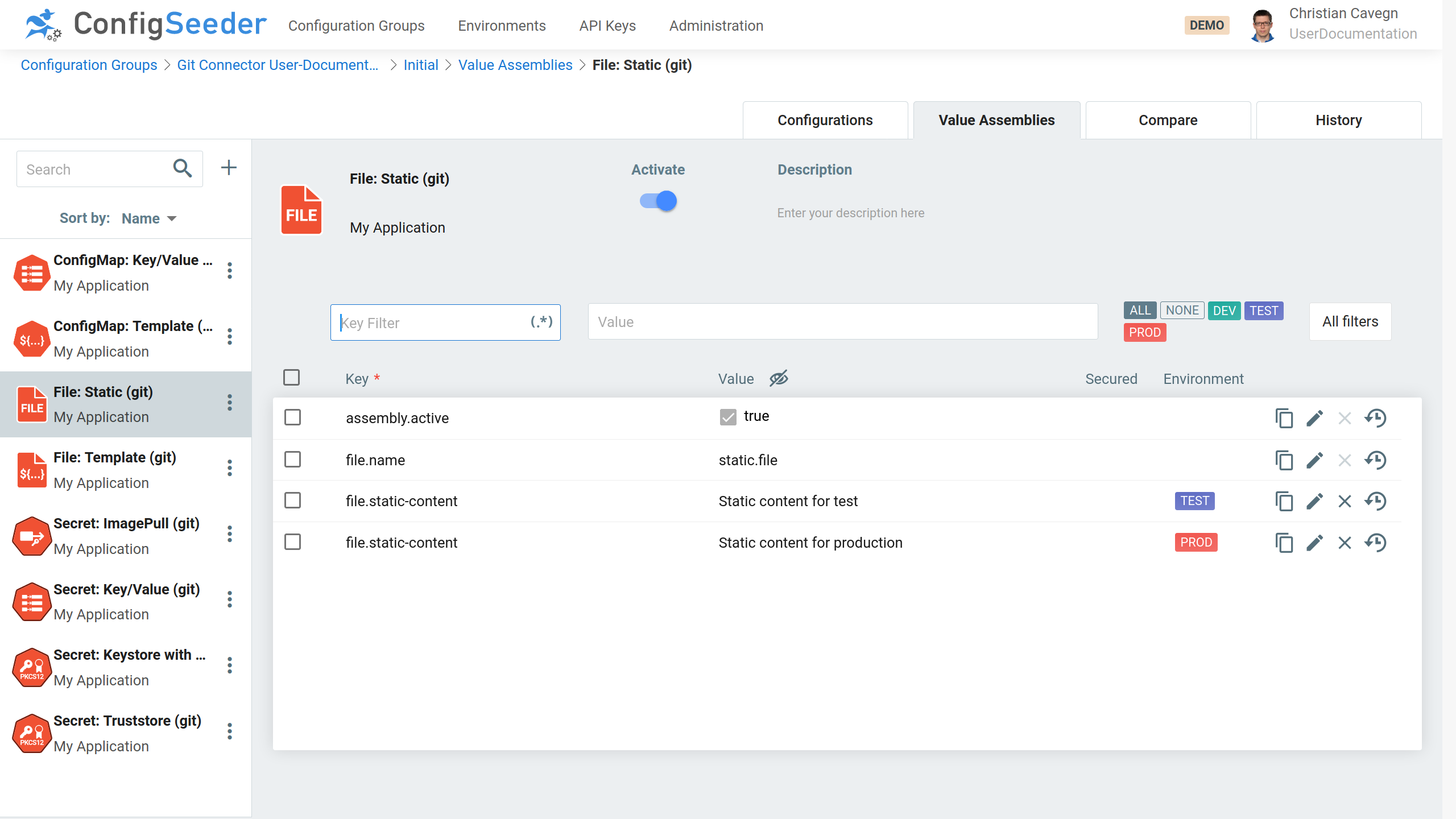
4.2.2. Configuration Values within Value Assemblies
| Key | Mandatory | Value |
|---|---|---|
|
yes |
Static content of the file. If a different file content is required for different environments (or other filter criteria), there could be
|
4.3. Template Files (File Module)
4.3.1. Introduction
This module is responsible for creating configuration files with a templating mechanism. The configuration values used for templating are stored in one or more referenced configuration groups.
Template Files are configured with Value Assemblies of type File: Template (Git):
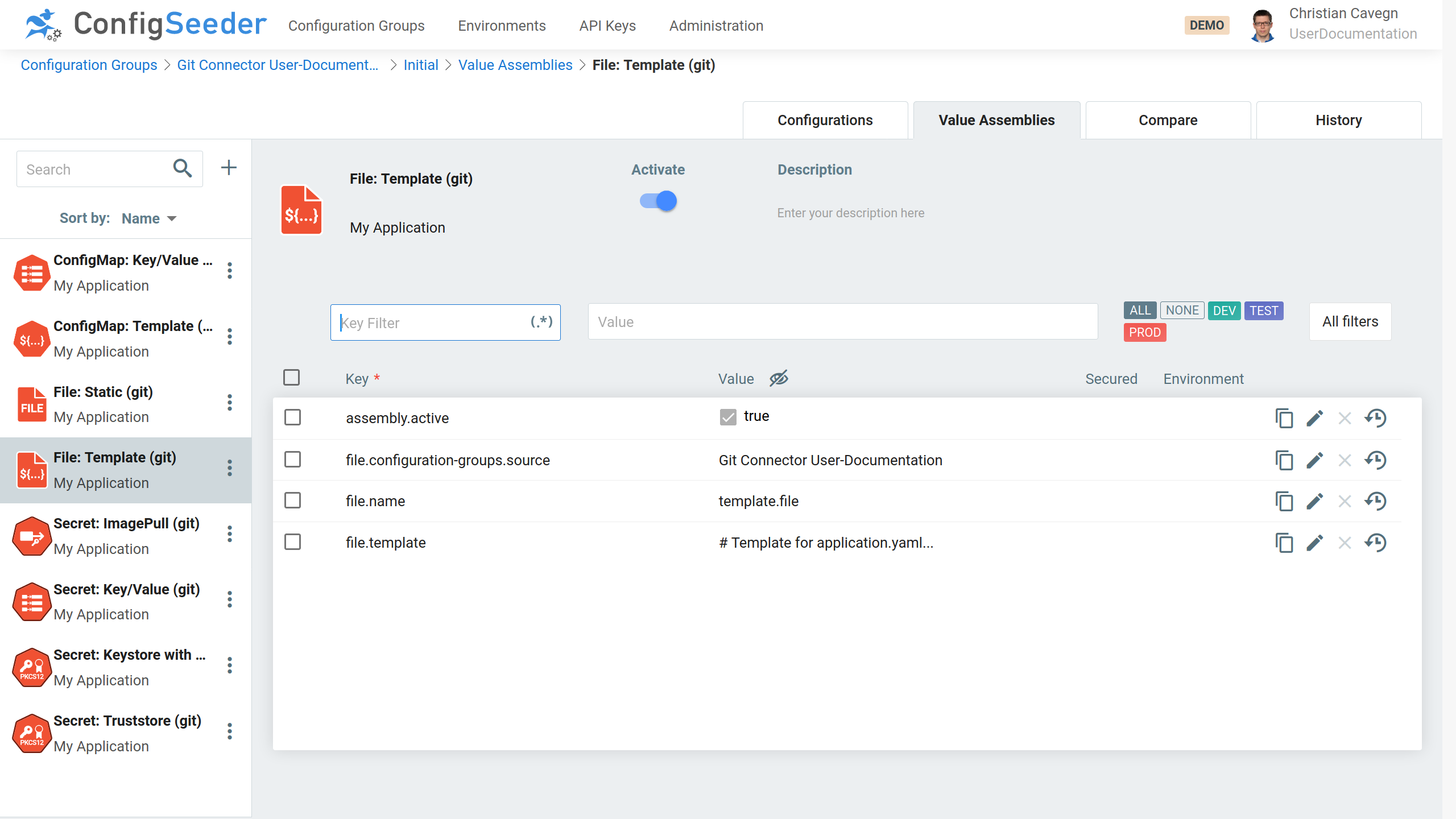
With the Template looking like this:
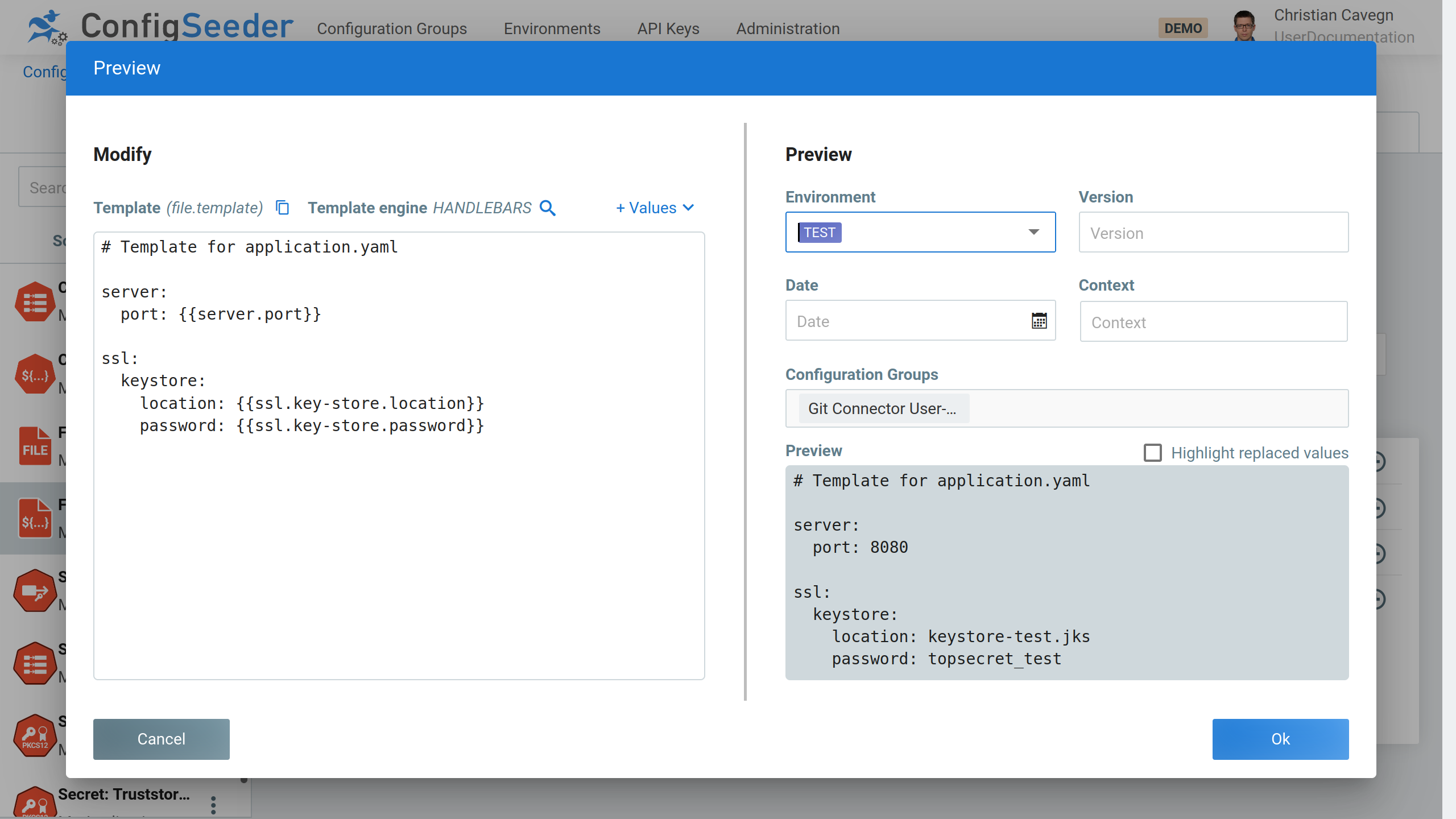
Define the following Configuration Values:

4.3.2. Configuration Values within Value Assemblies
| Key | Mandatory | Value |
|---|---|---|
|
yes |
Content/Template of the file. This content isn’t written directly to a VM, but first sent to the templating service of ConfigSeeder. See Supported templating engines. |
|
yes |
This value specifies which Configuration Groups are used for the templating. Defaults to the Configuration Group in which the Value Assembly is defined. |
4.4. ConfigMap: Key/Value (Module ConfigMap)
4.4.1. Introduction
This module is responsible for creating and managing ConfigMaps containing key / value pairs. The ConfigMaps are defined in Value Assemblies of type
ConfigMap: Key/Value (Git):
-
The key / value pairs can either be configured
-
directly in the Value Assembly
-
or be contained in a single or multiple referenced configuration groups.
-
-
Key / value pairs defined directly in the assembly overwrite key / value pairs defined in a referenced configuration group.
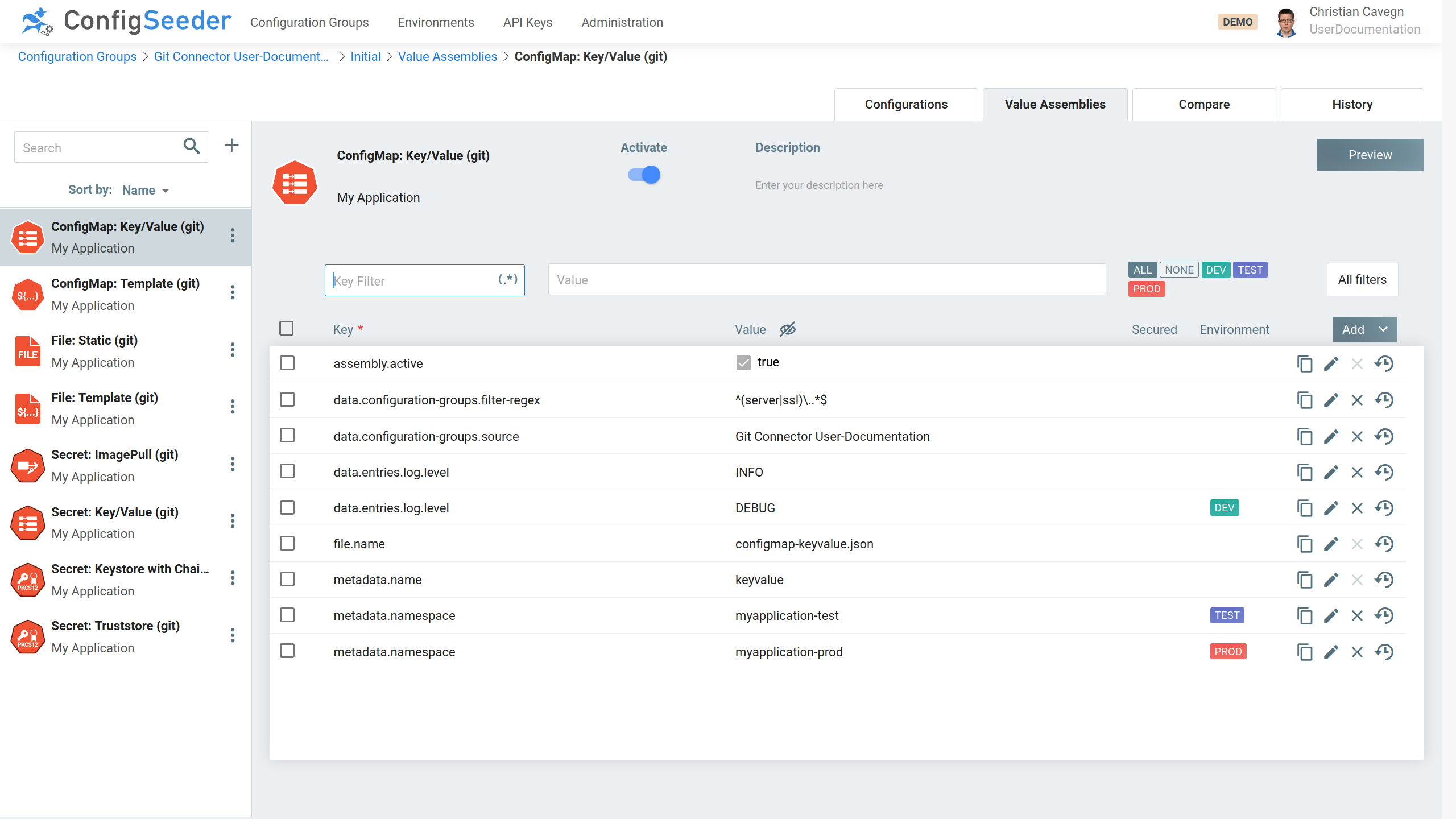
With the configuration group containing the following values:
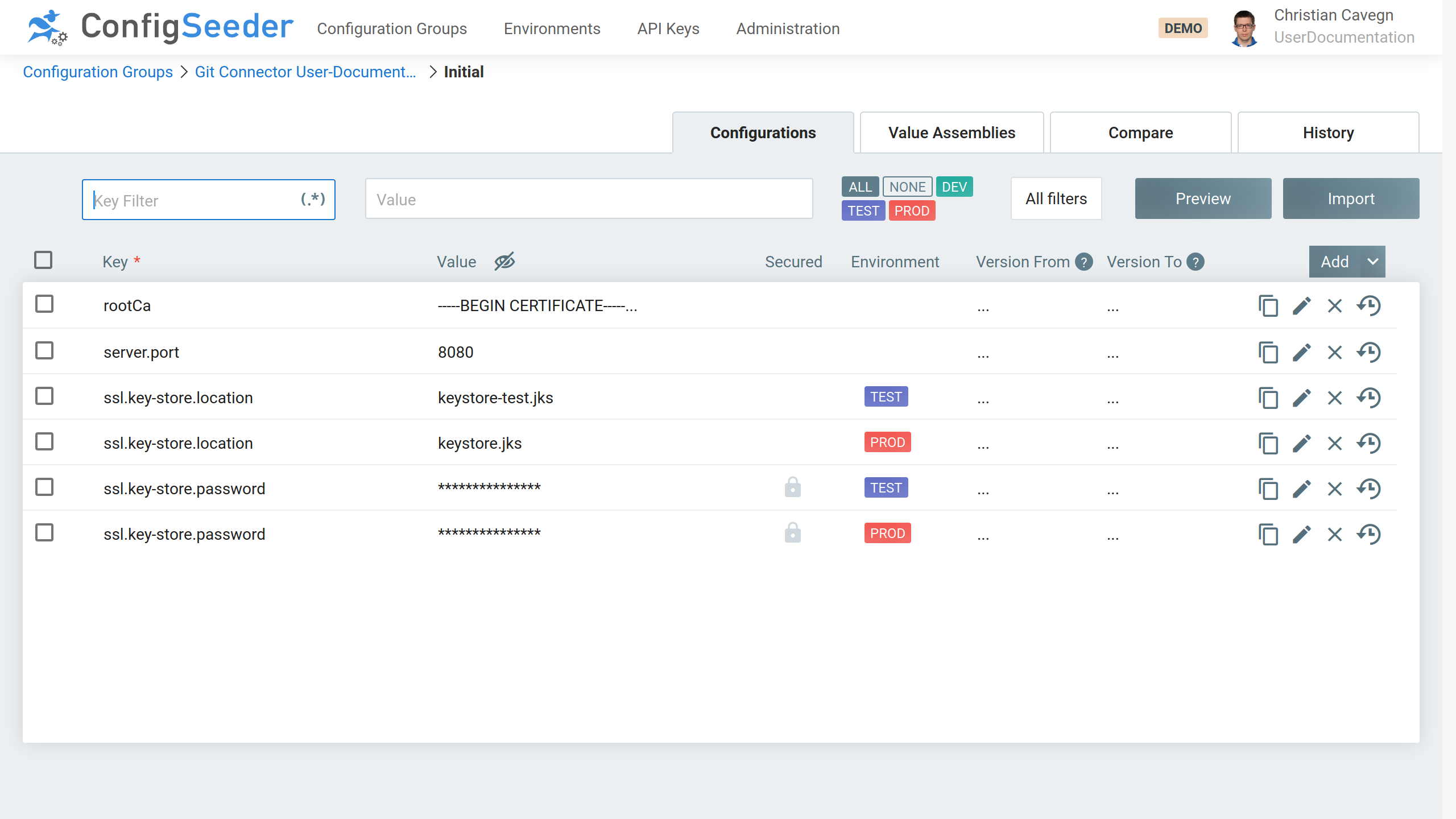
Check the preview:
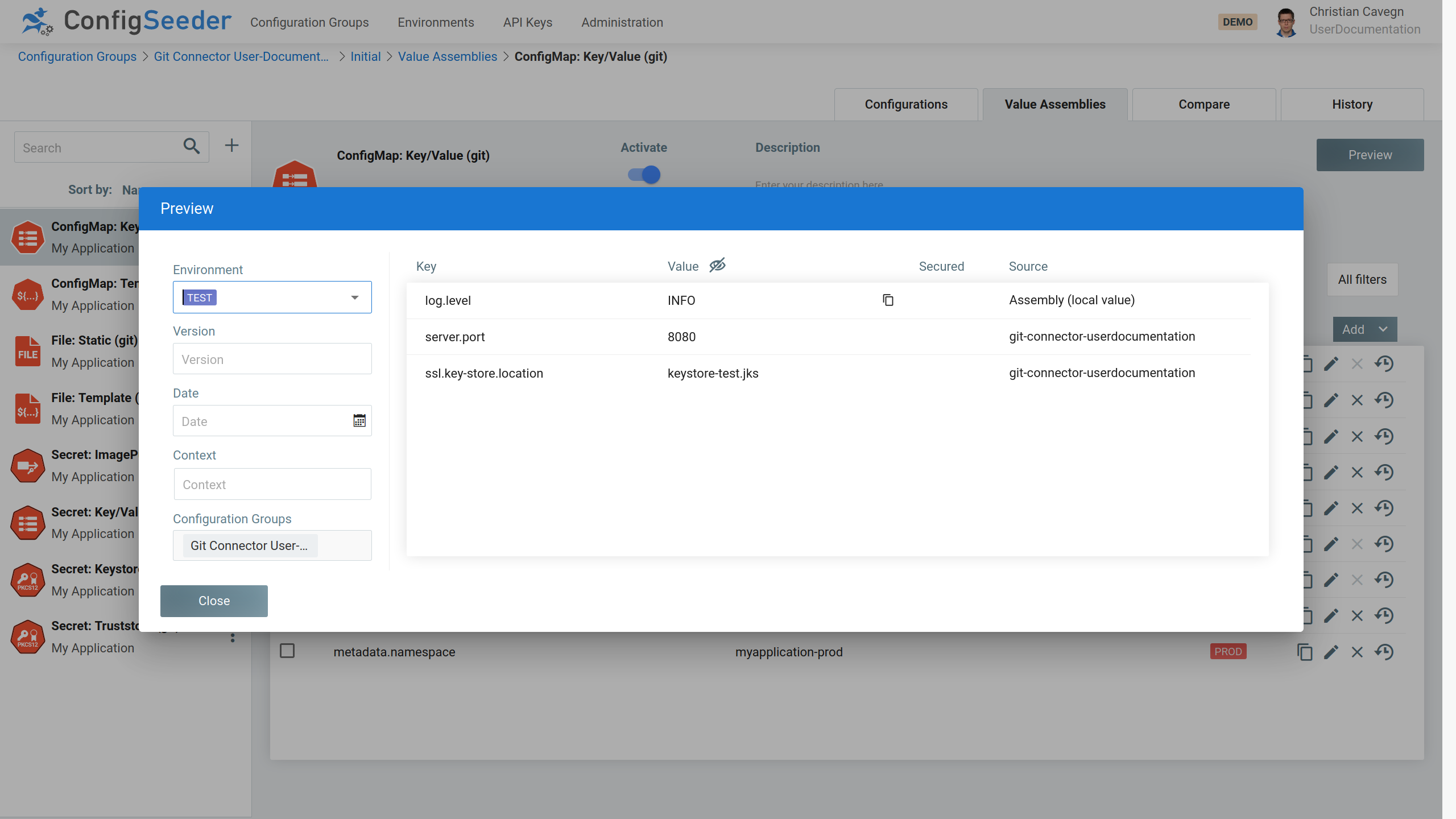
The example above would create a ConfigMap named keyvalue
-
in the namespace
myapplication-testcontaining the following data:-
log.level:INFO(on DEV it would beDEBUG) -
server.port:8080 -
ssl.key-store.location:keystore-test.jks
-
-
in the namespace
myapplication-prodcontaining the following data:-
log.level:INFO -
server.port:8080 -
ssl.key-store.location:keystore.jks
-
The key ssl.key-store.password is marked as secured and is therefore ignored when creating the ConfigMap.
The created kubernetes object will look like this:
kubectl get cm -n myapplication-test keyvalue -o json
{
"kind": "ConfigMap",
"apiVersion": "v1",
"metadata": {
"name": "keyvalue",
"namespace": "myapplication-test",
"annotations": {
"configseeder.com/dataHash": "f6e0a03c2502663b1acc22fc4926534609ccc37c15706d5664eb550f59209e77",
"configseeder.com/managed": "true",
"configseeder.com/module": "CMM_KV"
}
},
"data": {
"log.level": "8080",
"server.port": "8080"
"ssl.key-store.location": "keystore-test.jks"
}
}4.4.2. Usage of Configuration Values within Value Assembly
| Key | Mandatory | Value |
|---|---|---|
|
no |
Reference to one ore more configuration groups. The ConfigMap created by this module will contain all key / value pairs. |
|
no |
If configured, only keys matching the pattern will be included in the ConfigMap. To include all keys:
To include all keys with prefix / infix / postfix:
To include exactly two specified keys:
|
key2)$` |
|
no |
|
When managing a ConfigMap with ConfigSeeder
|
4.5. ConfigMap: Template (Module CMM)
4.5.1. Introduction
This module is responsible for creating and managing ConfigMaps containing key / value pairs. The values are created by templating and normally contain whole files.
The ConfigMap is defined with a Value Assemblies of type ConfigMap: Template (Git).
The configuration values used for templating are stored in one or more referenced configuration groups.
Configuration of a ConfigMap: Template Assembly in ConfigSeeder:
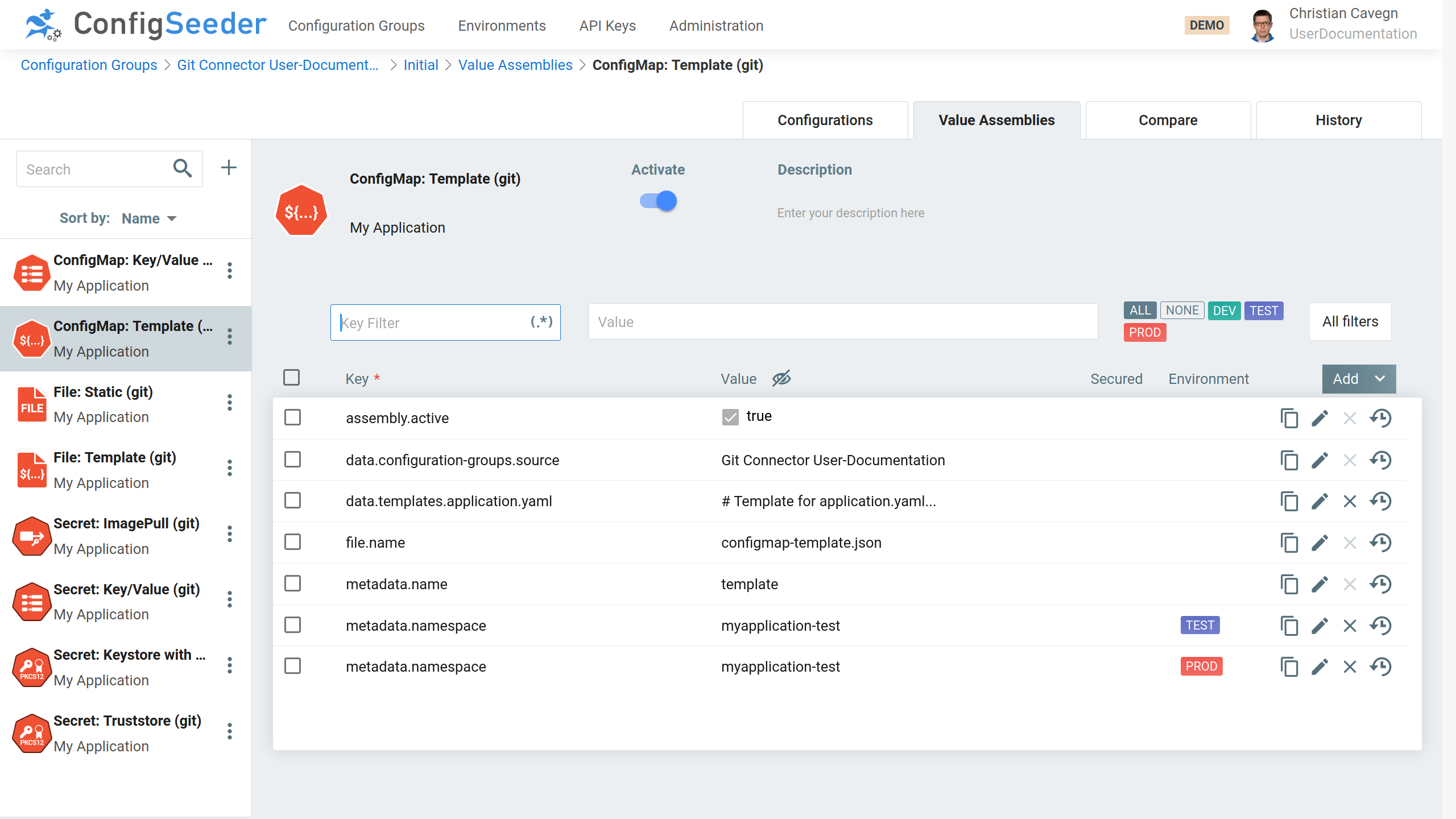
With the Template looking like this:

Define the following Configuration Values:
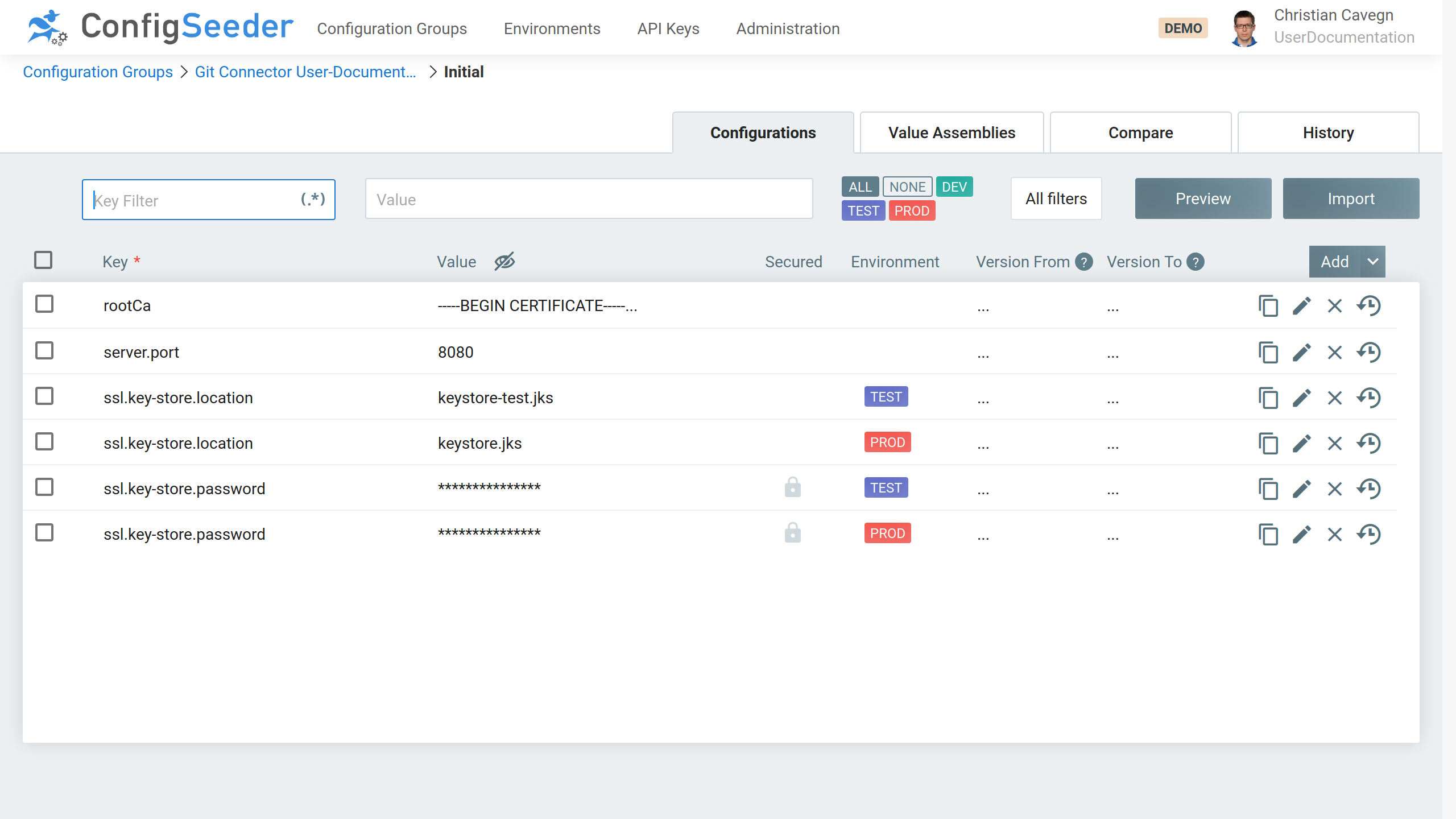
The example above would create a ConfigMap named template in the namespace myapplication-test (and …-prod).
The created kubernetes object should look like this:
kubectl get cm -n myapplication-test template -o yaml
apiVersion: v1
data:
application.yaml: |-
# Template for application.yaml
server:
port: 8080
ssl:
keystore:
location: keystore-test.jks
password: topsecret_test
Cancel
kind: ConfigMap
metadata:
annotations:
configseeder.com/dataHash: fbc1e5cf39d8209fa29132595dc0da30409af56c4cb45d18642d04a375e77a85
configseeder.com/managed: "true"
configseeder.com/module: CMM_TEMPLATE
name: template
namespace: myapplication-test|
When managing a ConfigMap with ConfigSeeder
|
4.5.2. Usage of Configuration Values within Value Assembly
| Key | Mandatory | Value |
|---|---|---|
|
yes |
Reference to one ore more configuration groups. The ConfigMap created by this module will contain all key / value pairs. |
|
no |
Entry of the ConfigMap which is created by templating.
|
4.6. Secret: ImagePull (Module SMM)
4.6.1. Introduction
This module is responsible for creating and managing ImagePullSecrets.
Image pull secrets are defined with Value Assemblies of type Secret: ImagePull (Git) in ConfigSeeder:
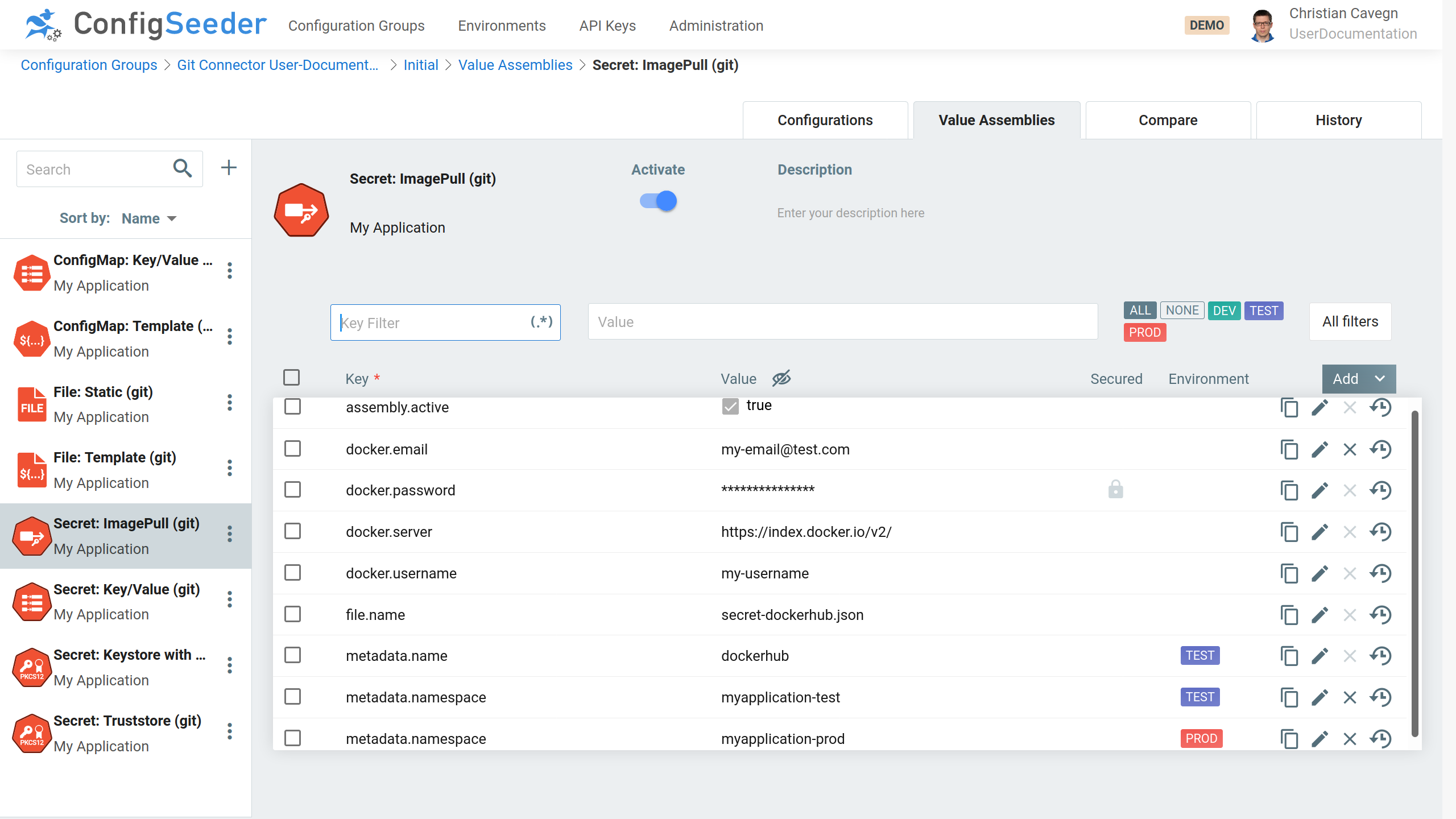
The example above would create a Secret named credentials-dockerhub
-
for the namespace
myapplication-testcontaining the following data:{ "apiVersion": "v1", "kind": "Secret", "type": "kubernetes.io/dockerconfigjson" "metadata": { "name": "credentials-dockerhub", "namespace": "myapplication-test", "creationTimestamp": null, "annotations": { "configseeder.com/dataHash": "d1e58006dc117b53a9705931ca738d8b403ced0875738f2e65e0483dff65c9eb", "configseeder.com/managed": "true", "configseeder.com/module": "SecretImagePullFileModule" } }, "data": { ".dockerconfigjson": "eyJhdXRocyI..." } } -
for the namespace
myapplication-prod, a similar secret is created.
4.6.2. Usage of Configuration Values within Value Assembly
| Key | Mandatory | Value |
|---|---|---|
|
yes |
Password required to log into the docker registry |
|
yes |
Url to the docker registry, defaults to |
|
yes |
Username required to log into the docker registry |
|
no |
Email address for the person responsible for the account connecting to the docker registry. |
4.7. Secret: Key/Value (Module SMM)
4.7.1. Introduction
This module is responsible for creating and managing Secrets containing key / value pairs. The ConfigMaps are defined in Value Assemblies of type
Secret: Key/Value (Git):
-
The key / value pairs can either be configured
-
directly in the Value Assembly
-
or be contained in a single or multiple referenced configuration groups.
-
-
Key / value pairs defined directly in the assembly overwrite key / value pairs defined in a referenced configuration group.
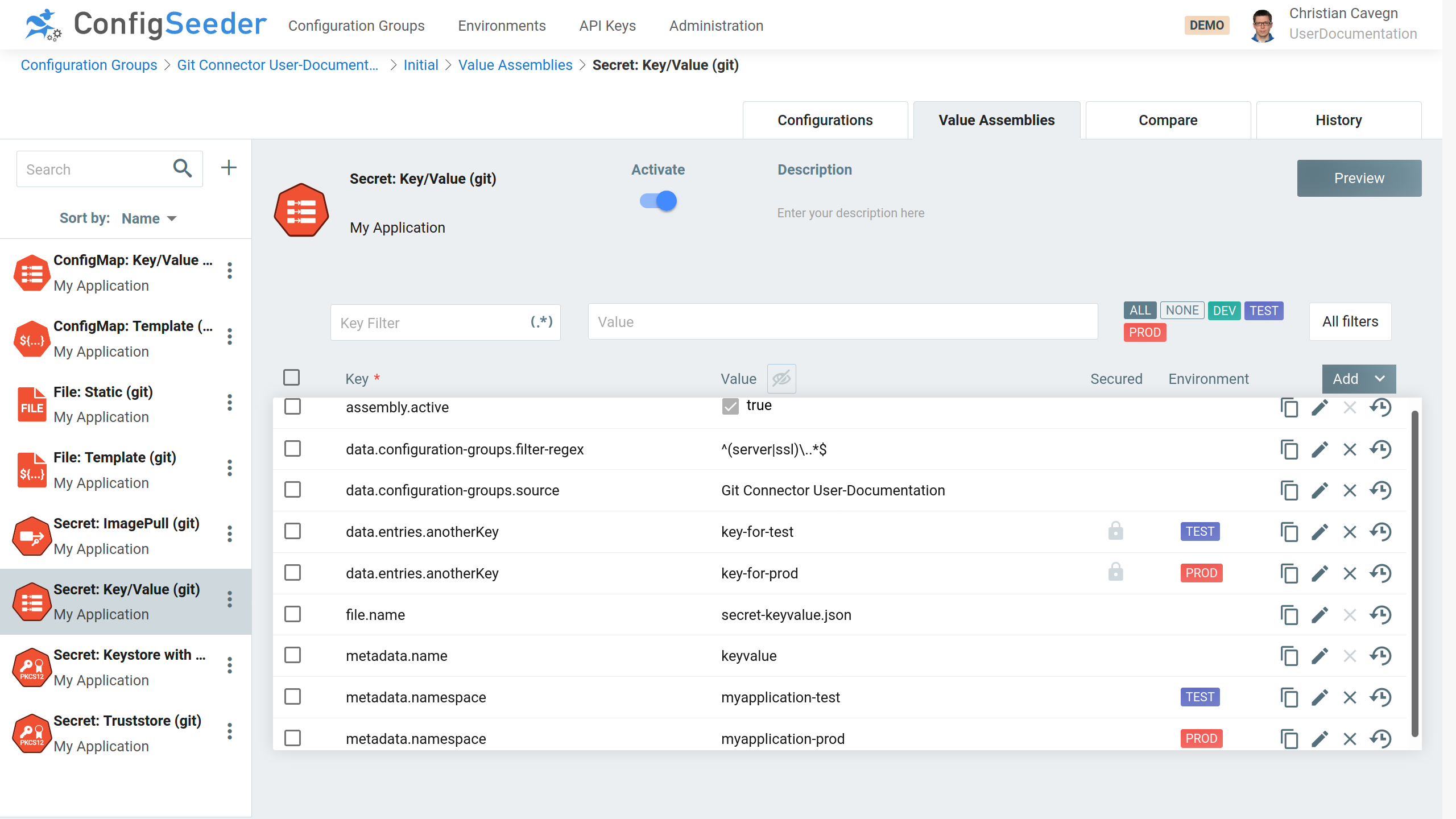
With the configuration group containing the following values:
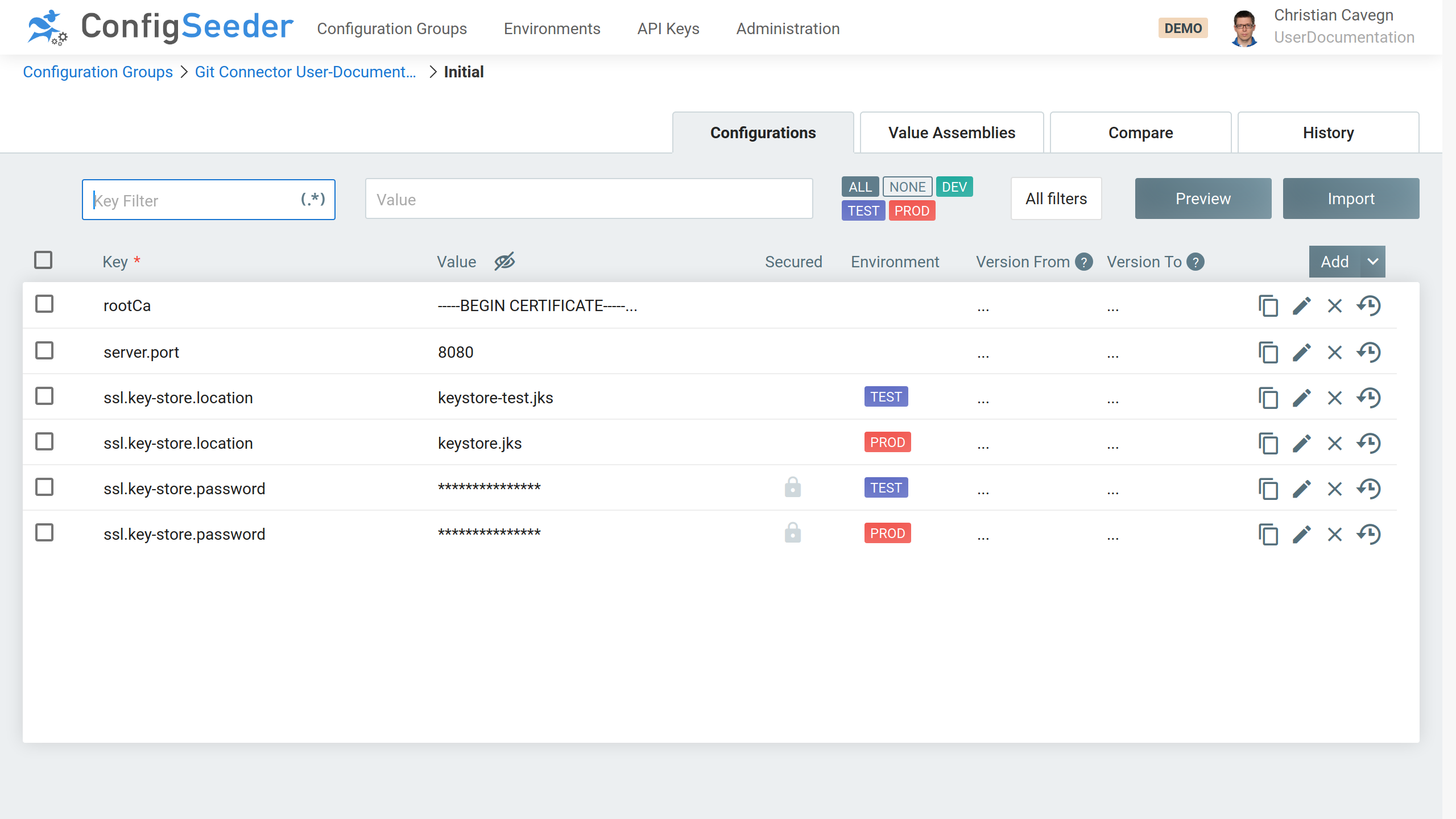
Check the preview:

The example above would create a Secret named keyvalue
-
in the namespace
myapplication-testcontaining the following data:-
anotherKey:key-for-test -
ssl.key-store.password:topsecret_test
-
-
in the namespace
myapplication-prodcontaining the following data:-
anotherKey:key-for-prod -
ssl.key-store.password:topsecret_prod
-
The other values in the configuration group not marked as secured and are therefore ignored when creating the ConfigMap.
This behavior can be overwritten with the Flag data.configuration-groups.include-unprotected.
The created kubernetes object should look like this:
kubectl get secret -n myapplication-test keyvalue -o json
{
"kind": "Secret",
"apiVersion": "v1",
"metadata": {
"name": "my-application-secret",
"namespace": "my-application-test",
"annotations": {
"configseeder.com/dataHash": "6e2e37c43d6e7cbece978b501a3ee37ab0f9796be0b31280db5b6138efd7588a",
"configseeder.com/managed": "true",
"configseeder.com/module": "SMM_KV"
}
},
"data": {
"anotherKey": "a2V5LWZvci10ZXN0",
"ssl.key-store.password": "dG9wc2VjcmV0X3Rlc3Q="
},
"type": "Opaque"
}4.7.2. Usage of Configuration Values within Value Assembly
| Key | Mandatory | Value |
|---|---|---|
|
no |
Reference to one ore more configuration groups. The Secret created by this module will contain all key / value pairs. |
|
no |
If configured, only keys matching the pattern will be included in the Secret. To include all keys:
To include all keys with prefix / infix / postfix:
To include exactly two specified keys:
|
|
yes |
Key-Value Entry which will be contained in the Secret. Key / Value Pairs defined with this mechanism will always overwrite values retrieved from a referenced configuration group. |
|
no |
Set to true, if unprotected values should be included in the secret. |
4.8. Secret: Keystore (Module SMM)
4.8.1. Introduction
This module is responsible for creating PKCS12 files containing only Certificates (Truststore) or also Private Keys (Keystore).
Keystores are configured with Value Assemblies of type Secret: Keystore (Git) in ConfigSeeder:

Add a certificate to your configuration group:
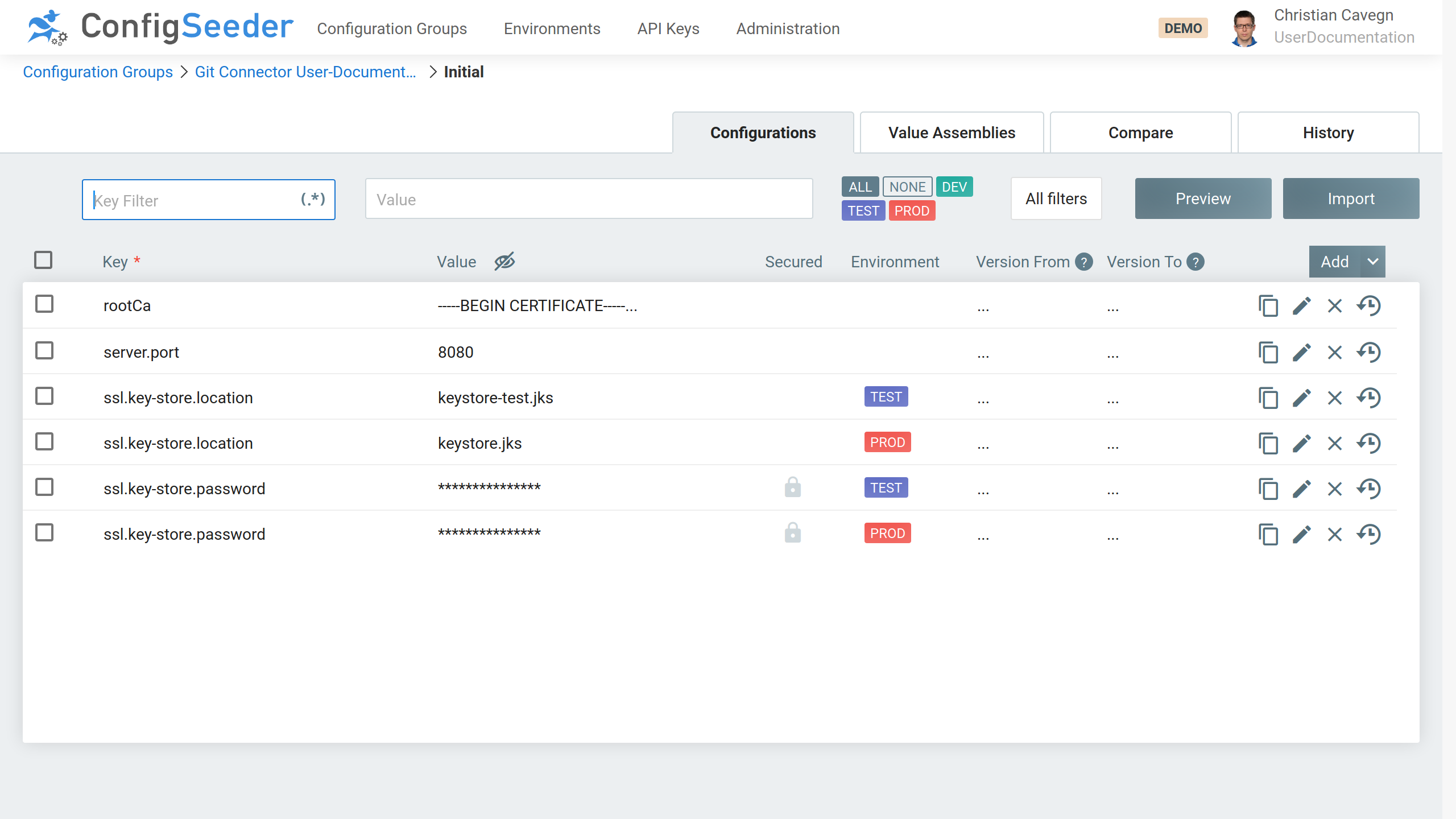
By hitting the preview Button, the keystore defined the assembly is created on the fly:

4.8.2. Configuration Values within Value Assemblies
| Key | Mandatory | Value |
|---|---|---|
|
no |
Reference to one or multiple configuration groups containing
certificates. All Configuration Values with the type
|
|
no |
Without this attribute, all Certificates contained in the configuration
groups referenced by This attribute enables to filter these certificates. Examples:
|
|
yes |
Password of the Key-/Truststore Requirements:
|
|
yes |
Type of the Keystore. Supported are
|
|
The following configuration values have an |
|
|
no |
Password if the private key is stored encrypted in ConfigSeeder®. It the private key is not stored encrypted, this password will be ignored. |
|
no |
PEM encoded Private Key
|
|
no |
PEM encoded Certificate
|
|
no |
Password with which the private key is protected when stored in the key store. This password can only be set for Keystores with type |
4.9. Supported templating engines
In the current version, the Git Connector supports the following template engines:
| Template Engine | Description |
|---|---|
HANDLEBARS |
Templating based on the handlebars templating engine, see https://handlebarsjs.com/ Supports simple variable replacement as well as more complex constructs like |
SIMPLE |
Simple template engine implementation that just replaces variables pre-/postfixed by |